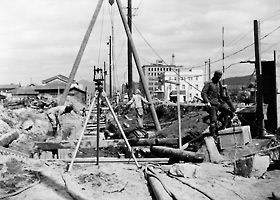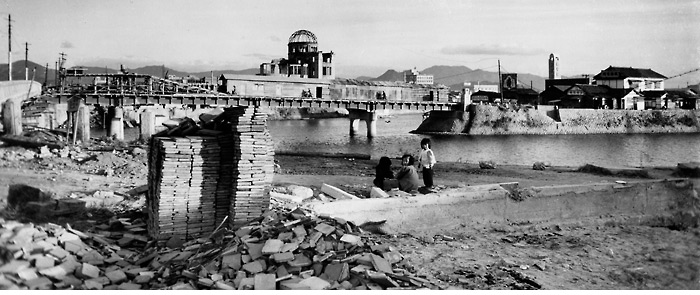Reconstructing the City
In 1949, the Hiroshima Peace Memorial City Construction Law was finally enacted. The free concession of former military and other national property, and an increased rate for government subsidies helped with the reconstruction of Hiroshima City. A full-fledged project to construct streets and parks, renovate rivers and green spaces, as well as secure sites for that purpose, was initiated.
Sasaki rode a bicycle every day to capture the changing town of Hiroshima on camera.
Bridges and Roads
Due to the A-bombing, followed by a typhoon in September, and heavy rain in October, nearly 20 bridges were washed away, collapsed or subsided and became impassable, which made citizens' lives more difficult. Although emergency restoration work was carried out before long, the rebuilding of these bridges was a huge expense.
After the Hiroshima Peace Memorial City Construction Law was enacted, a full-fledged bridge-building program and the construction of highways based on the urban planning project became feasible.
 |
Highway construction in front of Shirakamisha Shrine1950
The Rijo Dori, which stretched from Kamiya-cho to Takanobashi and was originally 15 to 19 meters wide, was widened to 40 meters. The underground sewer pipe installation work was implemented concurrent with the widening work of the western part of the bridge. Buildings on the right are the Hiroshima Branch of the Bank of Japan (front) and the Fukoku Building (back).
|
|||
Inari-ohashi Bridge nearing completion1950
The Inari-machi Streetcar Bridge was replaced with a road and railway bridge, the Inari-ohashi Bridge, with the widening of the connecting road, Aioi Dori. The bridge on the left is the Inari-machi Streetcar Bridge, which was slightly restored but kept the same shape that it was bent in by the blast. On the right is the Inari-ohashi Bridge nearing completion.
|
 |
|||
 Restoration work on Aioi Bridge1949
The Aioi Bridge, the target of the atomic bombing, was used unrepaired, despite a major part of the parapet having been blown off. Part of the walkway was also raised due to the bombing. Full-fledged restoration work began in 1949.
|
